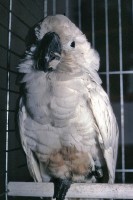iloveallthebirds
New member
- Dec 6, 2019
- 4
- 0
Hello,
I've just recently changed location and there are many wild cockatoos here (Whitsunday islands in Queensland, Australia).
I've noticed that many of them have brown feathers around their beaks, and on their bodies too.
They look a lot like this:
 https://www.flickr.com/photos/reyanimated/5230536093
https://www.flickr.com/photos/reyanimated/5230536093
I'm wondering why this is? And if there's anything I can do to potentially help them if they're unwell?
Thank you!
Delilah
I've just recently changed location and there are many wild cockatoos here (Whitsunday islands in Queensland, Australia).
I've noticed that many of them have brown feathers around their beaks, and on their bodies too.
They look a lot like this:

I'm wondering why this is? And if there's anything I can do to potentially help them if they're unwell?
Thank you!
Delilah






